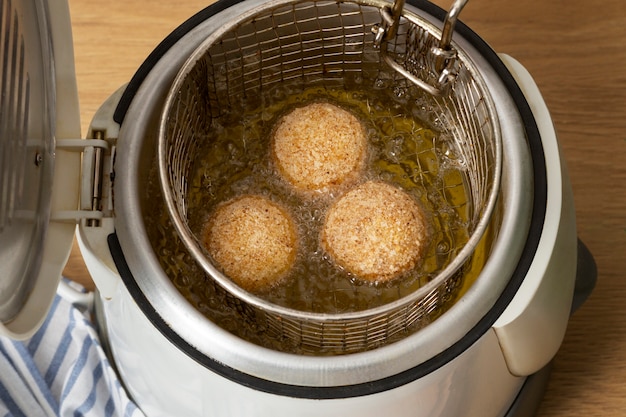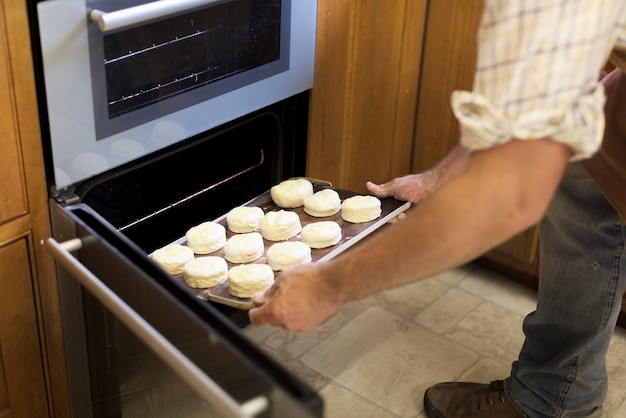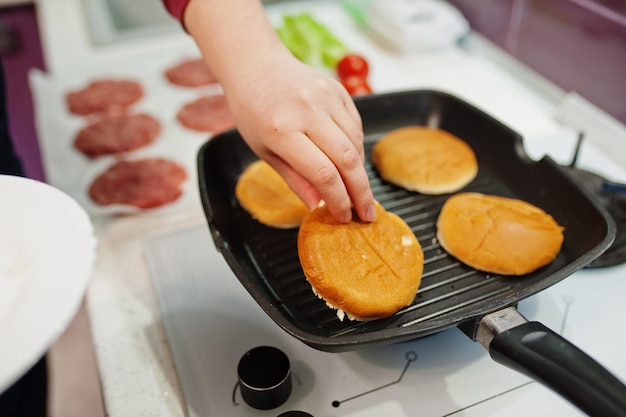I've always been a burger fanatic. There's just something about that perfect blend of juicy, flavorful meat, melty cheese, and all the delicious toppings that sends my taste buds into a frenzy. For years, I relied on traditional grilling methods, but they often left me with dry, underwhelming burgers. I yearned for a better way to achieve that heavenly, melt-in-your-mouth burger experience.
Then, one day, a culinary epiphany struck: oven-baked burgers. I was skeptical at first, picturing dry, flat patties. But I decided to take a leap of faith, and it was a game-changer! The oven's gentle heat yielded consistently juicy, flavorful results that surpassed anything I'd ever tasted. It was a revelation!
Not only did oven-baked burgers taste incredible, but they also offered a plethora of advantages over grilling. No more wrestling with fickle flames, battling flare-ups, or dealing with unevenly cooked patties. And best of all? No more smoky kitchen, leaving me smelling like a campfire for the rest of the day!
Over the past few years, I've dedicated myself to mastering the art of oven-baked burgers. I've experimented with countless variations, fine-tuning my techniques to achieve that perfect, mouthwatering result. And now, I'm thrilled to share my secrets with you, so you can elevate your burger game to a whole new level.
(Part 1) Unveiling the Science of Oven-Baked Burgers

Before we jump into the nitty-gritty details, let's explore the science behind why oven-baked burgers are so superior. It all comes down to the magic of convection.
The Power of Convection: Evenly Cooked Perfection
Imagine this: instead of direct heat from below, like grilling, the oven provides a more even distribution of heat. This allows the meat to cook uniformly from all sides, preventing that dreaded scenario of a perfectly seared exterior with a raw center. The oven's gentle embrace gradually cooks the burger from the inside out, ensuring every bite is bursting with flavor and moisture.
Moisture Retention: The Secret to juicy burgers
Another reason oven-baked burgers are so juicy is the oven's ability to retain moisture within the meat. The enclosed environment creates a humid atmosphere, acting like a cozy blanket that prevents the meat from drying out. This moisture retention is key to achieving that melt-in-your-mouth tenderness we all crave.
Flavor Enhancement: The Oven's Flavor Alchemy
The oven's enclosed environment also acts as a flavor amplifier. As the meat cooks, it releases juicy, flavorful compounds that are trapped within the oven, intensifying the overall taste. It's like a little flavor symphony happening inside the oven, creating a richer, more complex flavor profile than traditional grilling methods can achieve.
(Part 2) Choosing the Right Meat: The Foundation of Your Burger

The foundation of any great burger lies in the quality of the meat. When it comes to oven-baked burgers, you want to select meat that's flavorful, lean, but not too lean, and well-marbled.
ground beef: The Heart of the Matter
Ground beef is the quintessential burger ingredient, and choosing the right kind is crucial. Aim for ground beef that's at least 80% lean. Too lean, and your burger will be dry and tough. Too fatty, and it will be greasy and unappealing. A good balance of leanness and fat content is essential for achieving that perfect, juicy, and flavorful burger.
Beyond Beef: Exploring New Flavors
For those who want to venture beyond the realm of beef, there are plenty of other delicious options. Turkey, chicken, and lamb can all be used to create flavorful, oven-baked burgers. Each type of meat offers a unique flavor profile, so feel free to experiment and find your favorite.
Here are some tips to help you choose the best meat for your oven-baked burgers:
- Freshness is Key: Opt for fresh, high-quality meat. Fresh meat will have a bright red color and a firm texture. Avoid any meat that has a dull color or a slimy texture.
- Embrace Marbling: Look for meat with good marbling. Marbling refers to the streaks of fat throughout the meat, which contribute to flavor and juiciness.
- Consult the Experts: Don't be afraid to ask your butcher for advice! They can help you choose the right meat for your oven-baked burgers based on your preferences and desired level of leanness.
(Part 3) Mastering the Burger Shaping Technique: Creating Perfect Patties

With your meat chosen, it's time to shape those patties. The way you shape your burgers can significantly impact their texture and cooking results. You want to create perfectly formed patties that cook evenly and retain their juicy goodness.
The Hands-On Approach: Shaping with Care
I prefer using my hands to shape the burgers. It allows me to feel the meat and ensure it's evenly distributed, creating a consistent texture. Simply take a portion of your ground beef and gently form it into a patty. Don't overwork the meat, as this can make it tough.
Here are a few tips for shaping your burgers with your hands:
- Gentle Touch: Use a light touch when shaping the burgers. Don't press the meat too hard or you'll compact it, making it dense and tough. You want to keep it nice and loose for that juicy texture.
- Indentation for Even Cooking: Make a slight indentation in the center of the patty. This little trick helps to prevent the burger from puffing up in the center during cooking, ensuring even cooking and a perfectly flat surface.
- Size Matters: Shape the burgers to your desired size. The size of the burger will determine the cooking time. Larger burgers will take longer to cook.
Streamlining the Process: The Burger Press
If you're looking for a more efficient method, a burger press can be a fantastic tool. These handy gadgets allow you to create perfectly uniform burgers with ease. Simply place the meat in the press, close the lid, and press down to form a patty. Burger presses are especially helpful when making a large batch of burgers, as they ensure consistent size and shape.
(Part 4) Seasoning and Flavor Infusion: Elevating Your Burger Game
Now that your burgers are perfectly shaped, it's time to infuse them with flavor. The seasoning you choose can make a world of difference in the taste of your oven-baked burgers. Here are some seasoning tips and techniques to elevate your burger game.
Basic Seasoning: A Foundation for Flavor
A simple blend of salt and black pepper is a classic foundation for burger seasoning. These two ingredients enhance the natural flavors of the meat, creating a savory and satisfying base. Feel free to adjust the amount of salt and pepper to your liking.
Flavor Boosters: Adding Depth and Complexity
To take your burger seasoning to the next level, consider adding some of these flavor boosters to create a more complex and interesting taste profile:
- Garlic Powder: A dash of garlic powder adds a savory, pungent note to your burgers.
- Onion Powder: Onion powder imparts a subtle sweetness and savory aroma, adding another dimension of flavor.
- Paprika: Paprika adds a touch of sweetness and smokiness, particularly when using smoked paprika. It's a great option for adding a hint of smoky flavor.
- Dried Herbs: Thyme, rosemary, oregano, and parsley can all be used to add depth and complexity to your burger seasoning. Choose herbs that complement the type of meat you're using.
- Chili Powder: A sprinkle of chili powder adds a kick of heat and a smoky flavor. It's a great option for those who like a little spice in their burgers.
Seasoning Techniques: Infusing Flavor Through Different Methods
There are various ways to season your burgers. You can simply sprinkle the seasoning on the patties or rub it in with your fingers. For a more intense flavor, consider using a marinade or brine. Marinades are liquid-based mixtures that tenderize and flavor the meat, while brines are salt-based solutions that add moisture and enhance flavor.
(Part 5) Pre-Baking Prep: Setting the Stage for Burger Success
Before you send those burgers into the oven, there are a few pre-baking steps that can significantly improve their texture and flavor. These steps set the stage for a truly remarkable oven-baked burger experience.
Chill Time: A Crucial Step for Firmness and Flavor
One of the most important pre-baking steps is chilling the patties. Chilling helps to firm up the meat, making it easier to handle and preventing it from spreading too much during cooking. It also allows the flavors to meld, resulting in a more evenly seasoned and flavorful burger. It's like giving the flavors a chance to get cozy and mingle.
Chill the patties in the refrigerator for at least 30 minutes, or even better, for a couple of hours. This gives the meat enough time to firm up and absorb the seasoning.
Pan-Searing: Adding Depth and Texture
While not essential, pan-searing the burgers before baking can add another layer of flavor and texture. Heat a large skillet over medium-high heat and add a bit of oil. Sear the patties for a minute or two on each side, just enough to create a nice crust. This step caramelizes the exterior of the burgers, resulting in a deeper, more complex flavor.
(Part 6) Oven Baking: The Heart of the Process
Finally, it's time to bake your burgers to juicy, flavorful perfection. Here's a step-by-step guide to ensure a successful oven-baked burger experience.
Oven Temperature: Finding the Sweet Spot
Preheat your oven to 400°F (200°C). This temperature allows the burgers to cook quickly and evenly while maintaining their moisture. Adjust the temperature slightly depending on the thickness of your burgers and your preferred level of doneness. For thinner patties, you might want to reduce the temperature slightly to prevent over-browning.
Baking Time: A Guide to Doneness
The baking time will vary depending on the thickness of your burgers. As a general guideline, bake for 15-20 minutes for thinner patties and 20-25 minutes for thicker patties. It's important to check the internal temperature of the burgers to ensure they are cooked to your desired level of doneness. Use a meat thermometer to check the internal temperature. A safe internal temperature for ground beef is 160°F (71°C).
Baking Sheet: Providing a Stable Base for Even Cooking
Place your burgers on a baking sheet lined with parchment paper or foil. This helps to prevent the burgers from sticking to the baking sheet and ensures even cooking.
Resting Time: Letting the Juices Settle
Once your burgers are cooked, it's important to let them rest for a few minutes before serving. This allows the juices to redistribute throughout the meat, resulting in a more tender and flavorful burger. I usually rest my burgers for 5-10 minutes, but you can adjust the resting time based on your preferences.
(Part 7) Toppings and Assembly: Building Your Burger Masterpiece
After all that effort, it's time to top your oven-baked burgers and assemble your burger masterpiece. The beauty of oven-baked burgers lies in their versatility. You can create any combination of toppings you desire. Here are a few ideas to inspire your culinary creativity.
Classic Toppings: A Time-Honored Tradition
Classic toppings, like lettuce, tomato, onion, and pickles, are always a safe bet. These toppings add freshness and crunch, complementing the richness of the burger.
Cheese: A Melty Delight
No burger is complete without a generous layer of cheese. Choose your favorite cheese for a melty, flavorful topping. Cheddar, Monterey Jack, Swiss, and American are all popular choices.
Beyond the Basics: Exploring New Flavors
To venture beyond the classic toppings, consider incorporating some of these unique ingredients to create a truly custom burger experience:
- Roasted Peppers: Roasted red or yellow peppers add sweetness and a smoky flavor. They also add a beautiful color contrast.
- caramelized onions: Caramelized onions provide a sweet and savory flavor contrast, adding a depth of flavor that is hard to resist.
- Avocado: Creamy avocado adds a healthy dose of fats and a rich flavor, making for a delicious and satisfying topping.
- Bacon: crispy bacon adds a salty and smoky kick. It's a classic pairing that always elevates the burger experience.
- pickled onions: Pickled onions offer a tangy and sweet flavor contrast, adding a refreshing and slightly tart note.
- Guacamole: Homemade guacamole adds a vibrant, creamy flavor. It's a great option for those who love a touch of Mexican flair in their burgers.
- Sautéed Mushrooms: Sautéed mushrooms add a savory and earthy flavor, adding a delicious umami component to your burger.
(Part 8) Variations and Beyond: Expanding Your Burger Horizons
The beauty of oven-baked burgers lies in their versatility. You can experiment with different types of meat, flavors, and toppings to create endless variations. Here are a few ideas to inspire your culinary creativity.
Burger Sliders: Bite-Sized Delights
Oven-baked burgers are perfect for making sliders. Simply shape the ground beef into smaller patties and bake them as usual. Sliders are a great option for parties and gatherings, and they're perfect for serving with a variety of toppings.
Stuffed Burgers: A Flavorful Surprise
For a fun twist, try stuffing your burgers with cheese, bacon, or vegetables. Simply create a well in the center of the patty and fill it with your favorite fillings. Then, shape the patty around the filling, ensuring it's completely enclosed. Bake the stuffed burgers as usual.
Burger Bowls: A Healthier Twist
If you're looking for a lighter, healthier option, consider making burger bowls. Simply bake the burgers as usual and serve them over a bed of lettuce, quinoa, or rice. Top the bowls with your favorite toppings, such as avocado, salsa, and yogurt.
FAQs
Here are some frequently asked questions about oven-baked burgers.
1. Can I Use Frozen Meat?
While you can technically use frozen meat, it's best to thaw it completely before shaping and baking the burgers. This will ensure even cooking and prevent the meat from becoming tough. You can thaw frozen meat in the refrigerator overnight or by using the defrost setting on your microwave.
2. How Do I Know When My Burgers Are Done?
The best way to check for doneness is to use a meat thermometer. The internal temperature of a cooked hamburger should reach 160°F (71°C). If you don't have a thermometer, you can check for doneness by pressing the center of the burger. If the meat springs back and there's no pinkness, it's cooked through.
3. Can I Add Liquid to the Baking Pan?
Adding liquid to the baking pan can help to keep the burgers moist, but it can also make them soggy. If you do decide to add liquid, use a small amount, such as a tablespoon or two of water or broth. You can also add a few slices of onion or a sprig of rosemary to the baking pan to infuse the burgers with additional flavor.
4. What Happens If My Burgers Get Too Brown?
If your burgers start to brown too quickly, you can reduce the oven temperature to 375°F (190°C) or tent the burgers with aluminum foil. This will help to slow down the cooking process and prevent the burgers from becoming overcooked. Remember that once the burgers are removed from the oven, they will continue to cook slightly due to residual heat.
5. Can I Bake Burgers in a Different Shape?
Absolutely! Oven-baked burgers are incredibly versatile and can be baked in a variety of shapes. You can create square, rectangular, or even heart-shaped burgers. The possibilities are endless! Simply adjust the baking time based on the thickness and size of your burgers.
Everyone is watching

Corn on the Cob: The Ultimate Guide to Perfectly Cooked Ears
Healthy MealsAh, corn on the cob. Just the name evokes images of sunny days, barbecues, and that sweet, juicy flavour that ...

Perfect Pork Roast Oven Cooking Time: A Guide to Delicious Results
Healthy MealsThere's something truly satisfying about a perfectly roasted pork. The aroma alone is enough to make your mout...

Ham Cooking Time: How Long to Bake, Smoke, or Boil a Delicious Ham
Healthy MealsAh, ham. It's a classic, isn't it? A real crowd-pleaser, especially around holidays. And when done right, it'...

Scallops: The Ultimate Guide to Perfect Cooking
Healthy MealsAh, scallops. Those delicate, sweet, and utterly delicious morsels of the sea. They hold a special place in my...

Spaghetti Squash: The Ultimate Guide to Cooking and Serving
Healthy MealsRemember that time you saw spaghetti squash at the supermarket, looking all bumpy and strange, and thought, "W...
